-
Featured services
2026 Global AI Report: A Playbook for AI Leaders
Why AI strategy is your business strategy: The acceleration toward an AI-native state. Explore executive insights from AI leaders.
Access the playbook -
Services
View all services and productsLeverage our capabilities to accelerate your business transformation.
-
Services
Network Services
-
Services
Cloud
-
Services
Consulting
-
-
Services
Data and Artificial Intelligence
- AI and Intelligent Solutions
- Data/AI Strategy and Program
- Data Engineering and Platforms
- Data Governance and Management
- Data Visualization and Business Decision
- GenAI Consulting
- GenAI Platforms
- GenAI Industry Services
- GenAI Infrastructure Services
- GenAI Value Transformation
- View Data and Artificial Intelligence
-
Services
Infrastructure Solutions
-
Services
Global Data Centers
-
Services
CX and Digital Products
-
Services
Application Services
-
Services
Sustainability Services
-
Services
Digital Workplace
-
Services
Business Process Services
-
Services
Generative AI
-
Services
Cybersecurity
-
Services
Enterprise Application Platforms
![]()
Accelerate outcomes with agentic AI
Optimize workflows and get results with NTT DATA's Smart AI AgentTM Ecosystem
Create your roadmap -
-
-
Insights
Recent Insights
-
The Future of Networking in 2025 and Beyond
-
Using the cloud to cut costs needs the right approach
When organizations focus on transformation, a move to the cloud can deliver cost savings – but they often need expert advice to help them along their journey
-
Make zero trust security work for your organization
Make zero trust security work for your organization across hybrid work environments.
-
-
![]()
2026 Global AI Report: A Playbook for AI Leaders
Why AI strategy is your business strategy: The acceleration toward an AI-native state. Explore executive insights from AI leaders.
Access the playbook -
-
2026 Global AI Report: A Playbook for AI Leaders
Why AI strategy is your business strategy: The acceleration toward an AI-native state. Explore executive insights from AI leaders.
Access the playbook -
Discover how we accelerate your business transformation
-
About us
CLIENT STORIES
-
Liantis
Over time, Liantis – an established HR company in Belgium – had built up data islands and isolated solutions as part of their legacy system.
-
Randstad
We ensured that Randstad’s migration to Genesys Cloud CX had no impact on availability, ensuring an exceptional user experience for clients and talent.
-
-
CLIENT STORIES
-
Liantis
Over time, Liantis – an established HR company in Belgium – had built up data islands and isolated solutions as part of their legacy system.
-
Randstad
We ensured that Randstad’s migration to Genesys Cloud CX had no impact on availability, ensuring an exceptional user experience for clients and talent.
-
![]()
2026 Global AI Report: A Playbook for AI Leaders
Why AI strategy is your business strategy: The acceleration toward an AI-native state. Explore executive insights from AI leaders.
Access the playbook -
- Careers
Topics in this article
Global tensions, shifting trade routes, higher shipping costs, trade flow disruptions, raised tariffs in some regions and a fairly volatile trade environment overall: this is what the European logistics industry can expect in 2025.
Organizations will have to brave these headwinds while protecting their economic interests with a multipronged strategy focused on business and technology. This is likely to include diversifying the supply chain, shifting sourcing to regions with more favorable trade terms and investing in technology for operational efficiency — all while making good on their sustainability commitments.
Let’s examine the top supply chain trends and best practices for 2025 and beyond.
The industry trends
Conservative growth projections
The European transportation and logistics industry will grow at a conservative rate of just over 2%, held back by economic headwinds and a sluggish industrial sector. This is in line with the expected year-on-year growth in world trade volume of 3.2% in 2025, according to the International Monetary Fund.
We expect both labor challenges (skill shortages, working conditions and more) and workforce challenges (talent acquisition, employee engagement and automation) to affect the sector’s growth, with a specific impact on transportation and warehouse operations.
Despite the increased use of automation (drones and robotics), human labor will remain critical for the logistics industry, and organizations will have to provide competitive compensation, better working conditions and upskilling programs.
The rise of ecommerce
While the industrial sector might be sluggish, there is no slowdown in ecommerce — or in customer demands for rapid delivery. Nearly half of shippers say that consumers now expect delivery in under two days, according to the 2025 Third-Party Logistics Study by NTT DATA and partners.
To meet this rising need for speed, we expect to see the development of smaller, strategically located warehouses closer to customers. This will help to reduce last-mile transportation costs and improve delivery speeds. At the same time, the adoption of flexible and modular warehouse designs and operations will clip costs and improve efficiency by quickly scaling to keep pace with market dynamics.
More mergers and acquisitions
This year, larger logistics firms will acquire smaller players to gain scale and reach, but it’s difficult to predict exactly how many of these mergers or acquisitions will happen, and how quickly.
Follow best practice: build resilience into your supply chain
Overcome uncertainty by diversifying your supplier base and geographic locations and investing in technologies and partnerships to improve your delivery speed. This strategy will mitigate risks related to political instability, increased tariffs, natural disasters and supply chain disruptions in one region.
The technology trends
Widening adoption of digital and AI technologies
Digitalization and the adoption of automation and AI-related technologies will keep growing steadily this year, as these technologies hold great promise for making warehouse management and last-mile delivery more accurate, efficient and cost-effective.
The industry is also poised to adopt AI-powered systems to improve decision-making. Even though humans alone still make the lion’s share of manufacturing decisions, fully AI-driven decisions are on the horizon. In fact, NTT DATA’s Global GenAI Report shows that 51% of manufacturers plan to use GenAI-powered decision-management systems to streamline their back-office and midoffice processes, while 43% expect to gain improved business intelligence (that is, better decision-making) as an outcome of GenAI deployment.
An increased focus on better data practices
Advances in IoT devices and real-time data analytics mean we can expect a wider adoption of these technologies in inventory management and across the supply chain.
It’s worth noting that the human workforce will remain critical to the industry, even as organizations start deploying autonomous mobile robots, collaborative robots and drones in warehouse management, along with automated picking and palletizing systems for operational accuracy and workplace safety.
However, none of the above would be possible without better data processing. To benefit fully from advanced analytics and AI, organizations have to collect data that is contextually rich and structured in a way that AI and analytics tools can understand and use. This may involve rethinking how their data is captured and stored. Therefore, we expect a greater focus on data management for business optimization in 2025 and beyond.
Follow best practice: start small and scale up
To adopt automation and integrate AI into your supply chain, start with small, manageable projects and scale up from there. Focus on your data quality and processes, and provide training and upskilling opportunities to your employees, supported by change management. This approach will enable a smoother transition and build trust in new technologies.
The sustainability trends
Sustainability and environmental factors in the spotlight
Sustainability will remain a hot button, driven by increasingly eco-conscious consumers and regulatory pressures. Regulatory bodies and governments in Europe will continue to push organizations to reduce their carbon footprint and adopt sustainable practices. They will offer incentives for investing in clean energy and energy-efficient logistics infrastructure such as solar-powered warehouses and charging facilities for electric vehicles. Meanwhile, consumers will keep up the demand for eco-friendly products and practices.
The increased frequency of climate events, coupled with geopolitical tensions, will also force organizations to adopt multimodal logistics solutions (using different modes of transportation to move goods), dual sourcing and distributed warehousing to meet regulatory standards and plan for contingencies.
Follow best practice: set clear, measurable targets
Set measurable targets for your organization and commit to adopting environmentally friendly practices. Working toward clear goals will help you to track progress and make continuous improvements.
Be ready for new opportunities
The 2025 transportation and logistics industry is rife with challenges and opportunities. By adopting best practices, you can navigate the challenges while capitalizing on the opportunities that lie ahead.
NTT DATA’s Supply Chain Consulting combines world-class expertise with fact-based analytics in support of effective supply chains. With a holistic understanding of the connection between your supply chain and your IT initiatives, we keep you ahead of fast-changing trends in Europe and the rest of the world.




